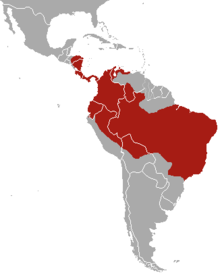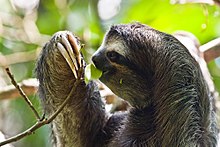
Xenarthra is a major clade of placental mammals native to the Americas. There are 31 living species: the anteaters, tree sloths, and armadillos. Extinct xenarthrans include the glyptodonts, pampatheres and ground sloths. Xenarthrans originated in South America during the late Paleocene about 60 million years ago. They evolved and diversified extensively in South America during the continent's long period of isolation in the early to mid Cenozoic Era. They spread to the Antilles by the early Miocene and, starting about 3 million years ago, spread to Central and North America as part of the Great American Interchange. Nearly all of the formerly abundant megafaunal xenarthrans became extinct at the end of the Pleistocene.

The giant anteater is an insectivorous mammal native to Central and South America. It is one of four living species of anteaters, of which it is the largest member. The only extant member of the genus Myrmecophaga, it is classified with sloths in the order Pilosa. This species is mostly terrestrial, in contrast to other living anteaters and sloths, which are arboreal or semiarboreal. The giant anteater is 182 to 217 cm in length, with weights of 33 to 50 kg for males and 27 to 47 kg for females. It is recognizable by its elongated snout, bushy tail, long fore claws, and distinctively colored pelage.

The pale-throated sloth, occasionally known as the ai, is a species of three-toed sloth that inhabits tropical rainforests in northern South America.
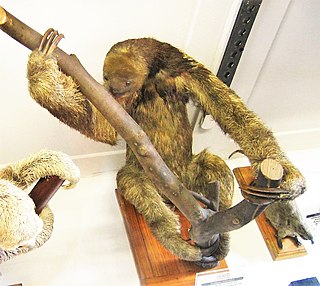
The maned sloth is a three-toed sloth that is native to South America. It is one of four species of three-toed sloths belonging to the suborder Xenarthra and are placental mammals. They are endemic to the Atlantic coastal rainforest of southeastern and northeastern Brazil, located in the states of Espírito Santo, Rio de Janeiro and Bahia. Each of the individuals within the species are genetically distinct with different genetic makeup.The maned sloth is listen under Vulnerable (VU) according to the IUCN Red List and have a decreasing population trend.

The silky anteater, also known as the pygmy anteater, has traditionally been considered a single species of anteater, Cyclopes didactylus, in the genus Cyclopes, the only living genus in the family Cyclopedidae. Found in southern Mexico, and Central and South America, it is the smallest of all known anteaters. It has nocturnal habits and appears to be completely arboreal; its hind feet are highly modified for climbing.
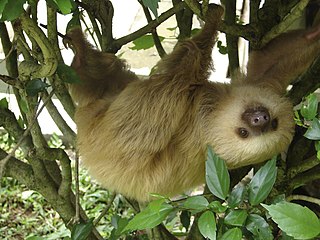
The Hoffmann's two-toed sloth, also known as the northern two-toed sloth, is a species of sloth from Central and South America. It is a solitary, largely nocturnal and arboreal animal, found in mature and secondary rainforests and deciduous forests. The common name commemorates the German naturalist Karl Hoffmann.

Linnaeus's two-toed sloth, also known as the southern two-toed sloth, unau, or Linne's two-toed sloth is a species of sloth from South America, found in Venezuela, Suriname, Guyana, French Guiana, Colombia, Ecuador, Peru, and Brazil north of the Amazon River. There is now evidence suggesting the species' range expands into Bolivia. It's the largest extant sloth species.
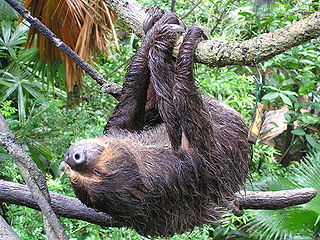
Choloepus is a genus of xenarthran mammals of Central and South America within the monotypic family Choloepodidae, consisting of two-toed sloths, sometimes also called two-fingered sloths. The two species of Choloepus, Linnaeus's two-toed sloth and Hoffmann's two-toed sloth, were formerly believed on the basis of morphological studies to be the only surviving members of the sloth family Megalonychidae, but have now been shown by molecular results to be closest to extinct ground sloths of the family Mylodontidae.
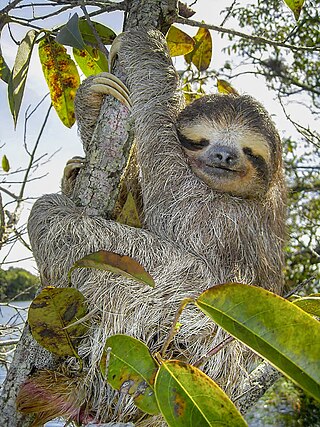
The three-toed or three-fingered sloths are arboreal neotropical mammals. They are the only members of the genus Bradypus and the family Bradypodidae. The five living species of three-toed sloths are the brown-throated sloth, the maned sloth, the pale-throated sloth, the southern maned sloth, and the pygmy three-toed sloth. In complete contrast to past morphological studies, which tended to place Bradypus as the sister group to all other folivorans, molecular studies place them nested within the sloth superfamily Megatherioidea, making them the only surviving members of that radiation.

Sloths are a Neotropical group of xenarthran mammals constituting the suborder Folivora, including the extant arboreal tree sloths and extinct terrestrial ground sloths. Noted for their slowness of movement, tree sloths spend most of their lives hanging upside down in the trees of the tropical rainforests of South America and Central America. Sloths are considered to be most closely related to anteaters, together making up the xenarthran order Pilosa.

The pygmy three-toed sloth, also known as the monk sloth or dwarf sloth, is a species of sloth in the family Bradypodidae. The species is endemic to Isla Escudo de Veraguas, a small island off the Caribbean coast of Panama. The species was first described by Robert P. Anderson of the University of Kansas and Charles O. Handley Jr., of the Smithsonian Institution in 2001. The pygmy three-toed sloth is significantly smaller than the other three members of its genus, but otherwise resembles the brown-throated three-toed sloth. According to Anderson and Handley Jr., the head-and-body length is between 48 and 53 centimetres, and the body mass ranges from 2.5 to 3.5 kg.

Acratocnus is an extinct genus of ground sloths that were found on Cuba, Hispaniola, and Puerto Rico.
The mammalian order Pilosa, which includes the sloths and anteaters, includes various species from the Caribbean region. Many species of sloths are known from the Greater Antilles, all of which became extinct over the last millennia, but some sloths and anteaters survive on islands closer to the mainland.

A sloth moth is a coprophagous moth which has evolved to exclusively inhabit the fur of sloths and to use sloth dung as a substrate for the early stages of reproduction. Sloth moths include Bradypodicola hahneli, Cryptoses choloepi, Cryptoses waagei, Cryptoses rufipictus, and Bradypophila garbei.
Cryptoses choloepi is a sloth moth in the snout moth family that as an adult lives exclusively in the fur of sloths, mammals found in South and Central America.

A large number of arthropods are associated with sloths. These include biting and blood-sucking flies such as mosquitoes and sandflies, triatomine bugs, lice, ticks and mites. The sloth’s fur forms a micro-ecozone inhabited by green algae and hundreds of insects. Sloths have a highly specific community of commensal beetles, mites and moths.

Rebecca Cliffe is a British zoologist, award winning conservationist, and one of the leading experts on sloth biology and ecology. She is the Founder and Executive Director of The Sloth Conservation Foundation and author of the book Sloths: Life in the Slow Lane.

TheSloth Conservation Foundation (SloCo) is a non-profit organisation based in Costa Rica that is dedicated to the protection of sloths living in wild and human-modified habitats through research, education and community-based conservation. SloCo was founded in 2017 by sloth researcher Dr. Rebecca Cliffe.

